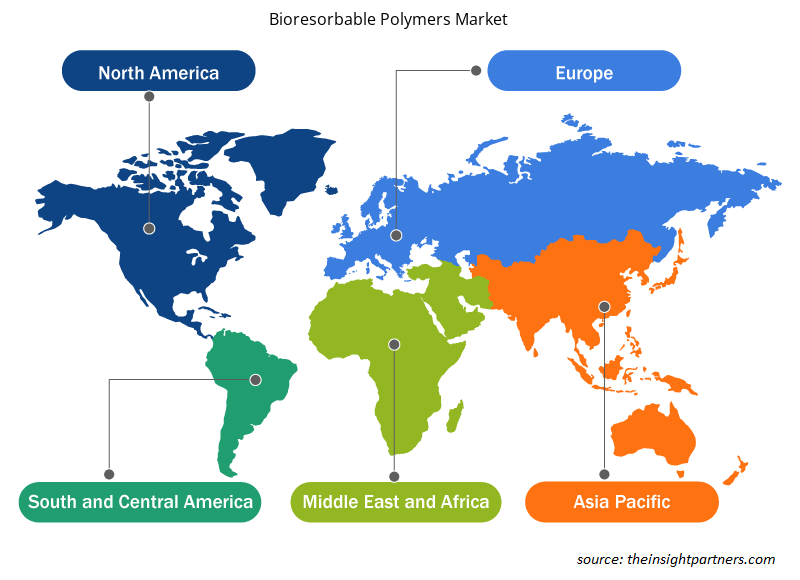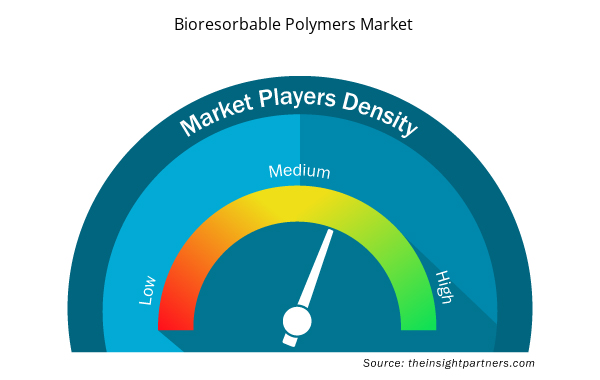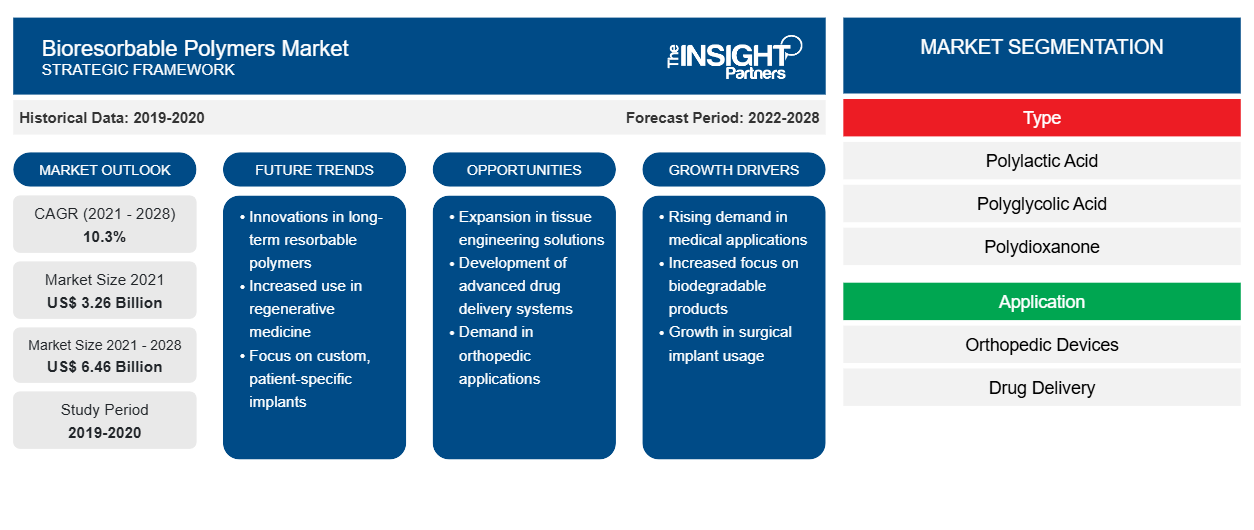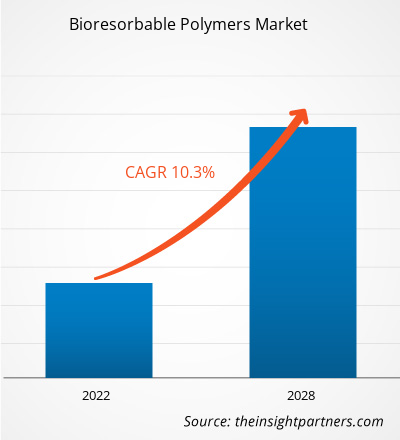Der Markt für bioresorbierbare Polymere wurde im Jahr 2021 auf 3.260,07 Millionen US-Dollar geschätzt und soll bis 2028 6.463,07 Millionen US-Dollar erreichen. Von 2021 bis 2028 wird ein durchschnittliches jährliches Wachstum von 10,3 % erwartet.
Bioresorbierbare Implantate auf Polymerbasis werden in der orthopädischen Chirurgie häufig zur Frakturfixierung eingesetzt. Orthopädische Implantate wie Interferenzschrauben, Platten, Stifte, Nahtanker, Meniskusreparaturimplantate und einfache Frakturfixierungsimplantate sind die am häufigsten verwendeten resorbierbaren Implantate für die Rekonstruktion des vorderen Kreuzbandes, Schulteroperationen, Meniskusreparaturen und die Frakturversorgung. Wenn diese Implantate in den Körper eingesetzt werden, erfüllen sie die gewünschte Wirkung und werden anschließend von selbst vom Körper absorbiert. Zu diesen resorbierbaren Implantaten auf Polymerbasis gehören Nähte, Schrauben, Stents, Platten, Stifte und andere, die in verschiedenen orthopädischen Unteranwendungen wie Traumata, Hüft-, Knie-, Wirbelsäulen-, Gelenk- und anderen Verletzungen verwendet werden. Diese Implantate zerfallen nach der Implantation während des Heilungs- und Stützprozesses auf natürliche Weise. Die Zunahme der Verkehrs- und Baustellenunfälle treibt daher die Nachfrage nach orthopädischen Implantaten an und treibt in der Folge das Wachstum des Marktes für bioresorbierbare Polymere voran .
Passen Sie diesen Bericht Ihren Anforderungen an
Sie erhalten kostenlos individuelle Anpassungen an jedem Bericht, einschließlich Teilen dieses Berichts oder einer Analyse auf Länderebene, eines Excel-Datenpakets sowie tolle Angebote und Rabatte für Start-ups und Universitäten.
- Holen Sie sich die wichtigsten Markttrends aus diesem Bericht.Dieses KOSTENLOSE Beispiel umfasst eine Datenanalyse von Markttrends bis hin zu Schätzungen und Prognosen.
Auswirkungen der COVID-19-Pandemie auf den Markt für bioresorbierbare Polymere
Die anhaltende COVID-19-Pandemie dürfte das Wachstum verschiedener Branchen weltweit erheblich beeinträchtigen. Die Unsicherheit hinsichtlich des zukünftigen Ausbruchs, insbesondere in Ländern wie Indien und einigen anderen asiatischen Ländern, hat jedoch den Status mehrerer Industriezweige verändert. Die Regierungen verschiedener Länder im asiatisch-pazifischen Raum haben mögliche Schritte unternommen, um die Ausbreitung des Virus einzudämmen, indem sie eine landesweite Ausgangssperre ankündigten, die sich direkt auf das Wachstum der Industriezweige auswirkt. Die Schließung von Produktionseinheiten und die Unterbrechung der Lieferkette haben den Markt behindert. In Indien gab es während der COVID-Pandemie einen Rückgang der Verkehrsunfälle. Laut dem Minister für Straßenverkehr und Autobahnen gab es einen Rückgang der Verkehrsunfälle um 26,48 %. Ein Rückgang der Verkehrsunfälle hat zu einem Rückgang der Tissue Engineering geführt , was die Nachfrage nach medizinischen Implantaten verringern und sich somit negativ auf den Markt für bioresorbierbare Polymere auswirken wird.
Markteinblicke
Zunehmende Anwendung des 3D-Gerüstdrucks für das Tissue Engineering
Die zunehmende Anwendung bioresorbierbarer Polymere zur Schaffung organähnlicher Strukturen mithilfe des 3D-Gerüstdrucks für die Gewebezüchtung gewinnt in der Gesundheitsbranche erheblich an Bedeutung. Bioresorbierbare Polymere verfügen über hervorragende Zellhaftungseigenschaften und eignen sich daher für Anwendungen in der Gewebezüchtung, wie etwa zur Regeneration von Knochen, Sehnen, Knorpel, Zähnen und der Wirbelsäule. Diese Polymere werden mithilfe verschiedener Techniken, wie etwa Elektrospinnen und Polymerdruck, zu Gerüsten verarbeitet, um Mikrostrukturen und Nanomaterialien zu erzeugen, die die Gewebeentwicklung erleichtern. Der 3D-Gerüstdruck kann hochkomplexe Designs mit steuerbaren Merkmalen für eine effiziente und reibungslose Gewebezüchtung erzeugen. Die Anwendung bioresorbierbarer Polymere für den 3D-Gerüstdruck wird voraussichtlich im Prognosezeitraum der zukünftige Trend in der Geweberegenerationsbehandlung und in diesem Markt sein.
Typ-Einblicke
Basierend auf dem Typ ist der globale Markt für bioresorbierbare Polymere in Polymilchsäure (PLA), Polyglykolsäure (PGA), Polydioxanon, Polycaprolacton (PCL) und andere unterteilt. Das Segment Polyglykolsäure (PGA) führte den Markt für bioresorbierbare Polymere mit dem größten Umsatzanteil im Jahr 2020 an.
Anwendungseinblicke
Basierend auf der Anwendung ist der globale Markt für bioresorbierbare Polymere in orthopädische Geräte, Arzneimittelverabreichung und andere segmentiert. Das Segment orthopädische Geräte führte den Markt für bioresorbierbare Polymere im Jahr 2020 an.
Bezwada Biomedical, LLC; Evonik Industries AG; Foster Corporation; Ashland; Musashino Chemical Laboratory, Ltd.; Huizhou Foryou Medical Devices Co., Ltd.; Polysciences, Inc.; BMG; Poly-Med Incorporated; und Reva Medical, LLC. sind die wichtigsten Hersteller von bioresorbierbaren Produkten auf der ganzen Welt. Diese Akteure konzentrieren sich aktiv auf Produktinnovationen, um mehr bioresorbierbare Materialien zu entwickeln, die für den menschlichen Körper geeignet sind, ohne Nebenwirkungen zu hinterlassen.
Regionale Einblicke in den Markt für bioresorbierbare Polymere
Die regionalen Trends und Faktoren, die den Markt für bioresorbierbare Polymere im Prognosezeitraum beeinflussen, wurden von den Analysten von Insight Partners ausführlich erläutert. In diesem Abschnitt werden auch die Marktsegmente und die Geografie für bioresorbierbare Polymere in Nordamerika, Europa, im asiatisch-pazifischen Raum, im Nahen Osten und Afrika sowie in Süd- und Mittelamerika erörtert.

- Erhalten Sie regionale Daten zum Markt für bioresorbierbare Polymere
Umfang des Marktberichts über bioresorbierbare Polymere
| Berichtsattribut | Details |
|---|---|
| Marktgröße im Jahr 2021 | 3,26 Milliarden US-Dollar |
| Marktgröße bis 2028 | 6,46 Milliarden US-Dollar |
| Globale CAGR (2021 - 2028) | 10,3 % |
| Historische Daten | 2019-2020 |
| Prognosezeitraum | 2022–2028 |
| Abgedeckte Segmente | Nach Typ
|
| Abgedeckte Regionen und Länder | Nordamerika
|
| Marktführer und wichtige Unternehmensprofile |
|
Marktteilnehmerdichte für bioresorbierbare Polymere: Auswirkungen auf die Geschäftsdynamik verstehen
Der Markt für bioresorbierbare Polymere wächst rasant, angetrieben durch die steigende Nachfrage der Endverbraucher aufgrund von Faktoren wie sich entwickelnden Verbraucherpräferenzen, technologischen Fortschritten und einem größeren Bewusstsein für die Vorteile des Produkts. Mit steigender Nachfrage erweitern Unternehmen ihr Angebot, entwickeln Innovationen, um die Bedürfnisse der Verbraucher zu erfüllen, und nutzen neue Trends, was das Marktwachstum weiter ankurbelt.
Die Marktteilnehmerdichte bezieht sich auf die Verteilung der Firmen oder Unternehmen, die in einem bestimmten Markt oder einer bestimmten Branche tätig sind. Sie gibt an, wie viele Wettbewerber (Marktteilnehmer) in einem bestimmten Marktraum im Verhältnis zu seiner Größe oder seinem gesamten Marktwert präsent sind.
Die wichtigsten auf dem Markt für bioresorbierbare Polymere tätigen Unternehmen sind:
- BMG Incorporated
- Evonik Industries AG
- Foster Corporation
- Ashland Global Holdings Inc.
- Poly-Med Incorporated
Haftungsausschluss : Die oben aufgeführten Unternehmen sind nicht in einer bestimmten Reihenfolge aufgeführt.

- Überblick über die wichtigsten Akteure auf dem Markt für bioresorbierbare Polymere
Bericht-Spotlights
- Fortschrittliche Branchentrends auf dem Markt für bioresorbierbare Polymere helfen den Akteuren bei der Entwicklung wirksamer langfristiger Strategien
- In Industrie- und Entwicklungsländern angewandte Strategien für Unternehmenswachstum
- Quantitative Analyse des Marktes für bioresorbierbare Polymere von 2019 bis 2028
- Schätzung der weltweiten Nachfrage nach bioresorbierbaren Polymeren
- Porters Analyse zur Veranschaulichung der Wirksamkeit der in der Branche tätigen Käufer und Lieferanten
- Aktuelle Entwicklungen zum Verständnis des Wettbewerbsmarktszenarios
- Markttrends und -aussichten sowie Faktoren, die das Wachstum des Marktes für bioresorbierbare Polymere vorantreiben und bremsen
- Unterstützung im Entscheidungsprozess durch Aufzeigen von Marktstrategien, die das kommerzielle Interesse untermauern und zum Marktwachstum führen
- Die Größe des Marktes für bioresorbierbare Polymere an verschiedenen Knotenpunkten
- Detaillierte Übersicht und Segmentierung des Marktes sowie der Dynamik der Branche für bioresorbierbare Polymere
- Größe des Marktes für bioresorbierbare Polymere in verschiedenen Regionen mit vielversprechenden Wachstumschancen
Markt für bioresorbierbare Polymere – nach Typ
- Polymilchsäure (PLA)
- Polyglykolsäure (PGA)
- Polydioxanon, Polycaprolacton (PCL)
- Sonstiges
Markt für bioresorbierbare Polymere – nach Anwendung
- Orthopädische Geräte
- Arzneimittelverabreichung
- Sonstiges
Firmenprofile
- Bezwada Biomedical, LLC
- Evonik Industries AG
- Foster Corporation
- Ashland
- Chemisches Labor Musashino, Ltd.
- Huizhou Foryou Medizinprodukte Co., Ltd.
- Polysciences, Inc.
- BMG
- Poly-Med Incorporated
- Reva Medical, LLC.
- Historische Analyse (2 Jahre), Basisjahr, Prognose (7 Jahre) mit CAGR
- PEST- und SWOT-Analyse
- Marktgröße Wert/Volumen – Global, Regional, Land
- Branche und Wettbewerbsumfeld
- Excel-Datensatz


- Excimer & Femtosecond Ophthalmic Lasers Market
- Embolization Devices Market
- Legal Case Management Software Market
- Hydrogen Compressors Market
- Social Employee Recognition System Market
- Artwork Management Software Market
- Webbing Market
- Artificial Intelligence in Healthcare Diagnosis Market
- Aerospace Forging Market
- Space Situational Awareness (SSA) Market

Report Coverage
Revenue forecast, Company Analysis, Industry landscape, Growth factors, and Trends

Segment Covered
This text is related
to segments covered.

Regional Scope
North America, Europe, Asia Pacific, Middle East & Africa, South & Central America

Country Scope
This text is related
to country scope.
Häufig gestellte Fragen
Asia Pacific is estimated to register the fastest CAGR in the market over the forecast period. The presence of high-growth markets such as India, China, and Japan due to the rapid increase in the geriatric population; increase in the number of hospitals; the implementation of favorable government initiatives; rise in investments in the healthcare industry; surge in demand for cutting-edge surgery products; and the expansion of private-sector hospitals in the rural areas are driving the market in the region. The increase in the elderly population across the region has led to a higher prevalence of osteoarthritis and other conditions, resulting in injuries requiring orthopedic devices.
The polylactic Acid (PLA) segment registered the fastest CAGR in the global bioresorbable polymers market. PLA is extensively used to manufacture medical implant devices and parts such as screws, pins, rods, and plates due to its biodegradable properties. The advantage of using PLA-based small parts in medical devices enables it to naturally convert into lactic acid in the body at low concentrations and can be safely removed by the body’s excretory system. Also, PLA is widely used in tissue engineering for bone tissue replacement purposes which is one of the most recent utilities of this polymer in medical science.
Orthopedic devices segment has led the bioresorbable polymers market in 2020, in terms of revenue. The orthopedic devices segment of the bioresorbable polymers market accounts for one of the largest revenue shares of the market. The growth of the segment can be attributed to the increasing sub-application of trauma, hip, knee, spine and bone surgery globally. The growing instances of accidents, sports injury, and the ageing population globally is surging the need for various joint and bone surgeries. Bioresorbable polymers are extensively used to make sutures, screws, stents, pins, rods, and plates in implant devices. After adding these devices to the body, they perform the desired action, and once done, these implants get absorbed in the body by themselves. Further, these implants break down naturally after implantation, during the healing and supporting process.
The polyglycolic acid segment of the bioresorbable polymers market is expected to grow at a notable rate in the forecast years. Polyglycolic acid is commonly used in scaffolds for various tissue engineering applications such as bone, tendon, cartilage, tooth, and spinal regeneration. Also, polyglycolic acid is a well-known alternative for PLA in orthopedic applications.
The major players operating in the bioresorbable polymers market are Bezwada Biomedical, LLC; Evonik Industries AG; Foster Corporation; Ashland; Musashino Chemical Laboratory, Ltd.; Huizhou Foryou Medical Devices Co., Ltd.; Polysciences, Inc.; BMG; Poly-Med Incorporated; and Reva Medical, LLC.
In 2020, North America held the largest revenue share of the global bioresorbable polymers market. The US and Canada mainly lead the demand for bioresorbable polymers in North America. Factors such as the growing number of FDA approvals for medical devices and the increasing presence of well-developed healthcare systems are driving the bioresorbable polymer market in the region. Further, the increased presence of orthopedic impairment patients in the region has led to a rise in demand for bioresorbable polymers.
Trends and growth analysis reports related to Chemicals and Materials : READ MORE..
The List of Companies - Bioresorbable Polymers Market
- BMG Incorporated
- Evonik Industries AG
- Foster Corporation
- Ashland Global Holdings Inc.
- Poly-Med Incorporated
- REVA Medical, LLC
- Musashino Chemical Laboratory, Ltd
- Huizhou Foryou Medical Devices Co., Ltd.
- Polysciences Inc
- Bezwada Biomedical LLC
The Insight Partners performs research in 4 major stages: Data Collection & Secondary Research, Primary Research, Data Analysis and Data Triangulation & Final Review.
- Data Collection and Secondary Research:
As a market research and consulting firm operating from a decade, we have published and advised several client across the globe. First step for any study will start with an assessment of currently available data and insights from existing reports. Further, historical and current market information is collected from Investor Presentations, Annual Reports, SEC Filings, etc., and other information related to company’s performance and market positioning are gathered from Paid Databases (Factiva, Hoovers, and Reuters) and various other publications available in public domain.
Several associations trade associates, technical forums, institutes, societies and organization are accessed to gain technical as well as market related insights through their publications such as research papers, blogs and press releases related to the studies are referred to get cues about the market. Further, white papers, journals, magazines, and other news articles published in last 3 years are scrutinized and analyzed to understand the current market trends.
- Primary Research:
The primarily interview analysis comprise of data obtained from industry participants interview and answers to survey questions gathered by in-house primary team.
For primary research, interviews are conducted with industry experts/CEOs/Marketing Managers/VPs/Subject Matter Experts from both demand and supply side to get a 360-degree view of the market. The primary team conducts several interviews based on the complexity of the markets to understand the various market trends and dynamics which makes research more credible and precise.
A typical research interview fulfils the following functions:
- Provides first-hand information on the market size, market trends, growth trends, competitive landscape, and outlook
- Validates and strengthens in-house secondary research findings
- Develops the analysis team’s expertise and market understanding
Primary research involves email interactions and telephone interviews for each market, category, segment, and sub-segment across geographies. The participants who typically take part in such a process include, but are not limited to:
- Industry participants: VPs, business development managers, market intelligence managers and national sales managers
- Outside experts: Valuation experts, research analysts and key opinion leaders specializing in the electronics and semiconductor industry.
Below is the breakup of our primary respondents by company, designation, and region:

Once we receive the confirmation from primary research sources or primary respondents, we finalize the base year market estimation and forecast the data as per the macroeconomic and microeconomic factors assessed during data collection.
- Data Analysis:
Once data is validated through both secondary as well as primary respondents, we finalize the market estimations by hypothesis formulation and factor analysis at regional and country level.
- Macro-Economic Factor Analysis:
We analyse macroeconomic indicators such the gross domestic product (GDP), increase in the demand for goods and services across industries, technological advancement, regional economic growth, governmental policies, the influence of COVID-19, PEST analysis, and other aspects. This analysis aids in setting benchmarks for various nations/regions and approximating market splits. Additionally, the general trend of the aforementioned components aid in determining the market's development possibilities.
- Country Level Data:
Various factors that are especially aligned to the country are taken into account to determine the market size for a certain area and country, including the presence of vendors, such as headquarters and offices, the country's GDP, demand patterns, and industry growth. To comprehend the market dynamics for the nation, a number of growth variables, inhibitors, application areas, and current market trends are researched. The aforementioned elements aid in determining the country's overall market's growth potential.
- Company Profile:
The “Table of Contents” is formulated by listing and analyzing more than 25 - 30 companies operating in the market ecosystem across geographies. However, we profile only 10 companies as a standard practice in our syndicate reports. These 10 companies comprise leading, emerging, and regional players. Nonetheless, our analysis is not restricted to the 10 listed companies, we also analyze other companies present in the market to develop a holistic view and understand the prevailing trends. The “Company Profiles” section in the report covers key facts, business description, products & services, financial information, SWOT analysis, and key developments. The financial information presented is extracted from the annual reports and official documents of the publicly listed companies. Upon collecting the information for the sections of respective companies, we verify them via various primary sources and then compile the data in respective company profiles. The company level information helps us in deriving the base number as well as in forecasting the market size.
- Developing Base Number:
Aggregation of sales statistics (2020-2022) and macro-economic factor, and other secondary and primary research insights are utilized to arrive at base number and related market shares for 2022. The data gaps are identified in this step and relevant market data is analyzed, collected from paid primary interviews or databases. On finalizing the base year market size, forecasts are developed on the basis of macro-economic, industry and market growth factors and company level analysis.
- Data Triangulation and Final Review:
The market findings and base year market size calculations are validated from supply as well as demand side. Demand side validations are based on macro-economic factor analysis and benchmarks for respective regions and countries. In case of supply side validations, revenues of major companies are estimated (in case not available) based on industry benchmark, approximate number of employees, product portfolio, and primary interviews revenues are gathered. Further revenue from target product/service segment is assessed to avoid overshooting of market statistics. In case of heavy deviations between supply and demand side values, all thes steps are repeated to achieve synchronization.
We follow an iterative model, wherein we share our research findings with Subject Matter Experts (SME’s) and Key Opinion Leaders (KOLs) until consensus view of the market is not formulated – this model negates any drastic deviation in the opinions of experts. Only validated and universally acceptable research findings are quoted in our reports.
We have important check points that we use to validate our research findings – which we call – data triangulation, where we validate the information, we generate from secondary sources with primary interviews and then we re-validate with our internal data bases and Subject matter experts. This comprehensive model enables us to deliver high quality, reliable data in shortest possible time.


 Holen Sie sich ein kostenloses Muster für diesen Bericht
Holen Sie sich ein kostenloses Muster für diesen Bericht